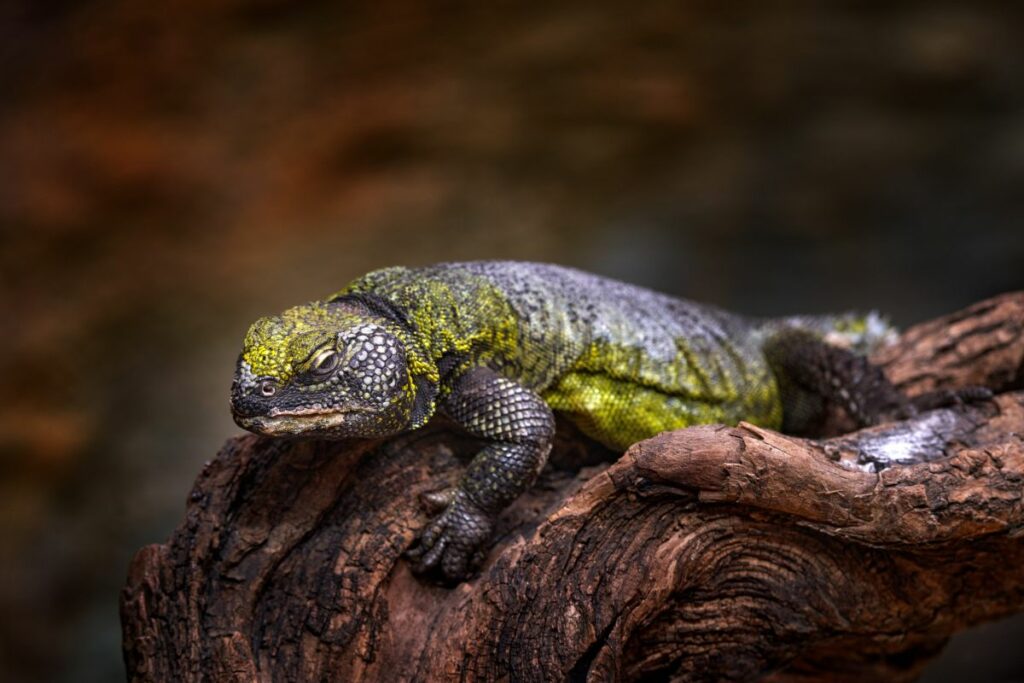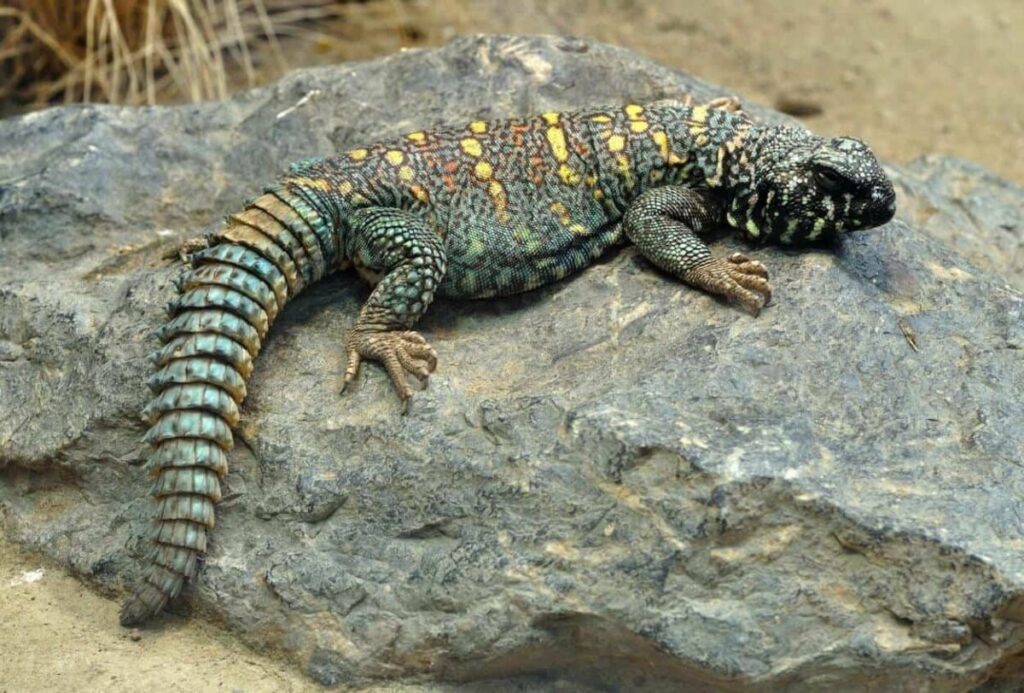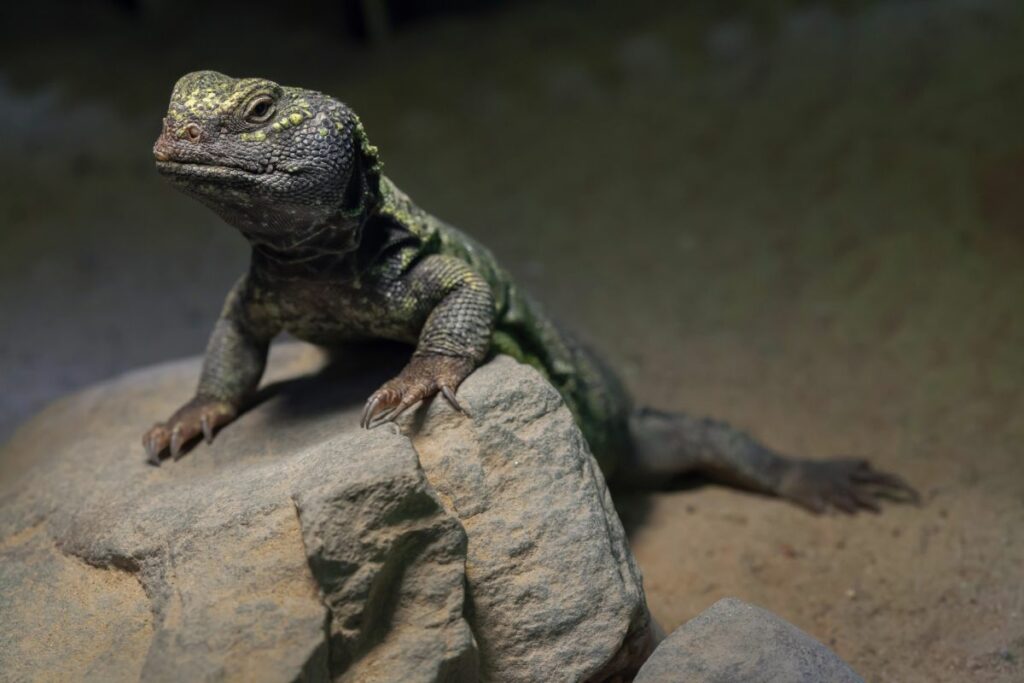Uromastyx lizards look like little dinosaurs, with their spiked tails and large claws. Despite their fierce appearance, uromastyx are even-tempered. A quality that makes them popular with reptile keepers.

Feeding them is more complicated compared to other pet lizards since they don’t eat prepared foods or insects. But if you have the foundations of reptile care down, uromastyx are an ideal lizard for beginners.
What is the Uromastyx Lizard?
Uromastyx are not a single species of lizard; it is a genus name for several close relatives. These lizards live in the deserts of North Africa and the Middle East, from Morocco to Iran. A related group of lizards (genus Saara) are found further east, into Pakistan and India.
They are uncommon in the pet trade compared to green iguanas, leopard geckos, and other familiar species. But most reptile stores either carry uromastyx or are able to special-order them.
Almost all uromastyx are bred in captivity. As a result, you will find varieties that are much more intense in color than their wild forebears. Names like “Saharan Red” and “Yellow Niger” attest to their vivid hues.
Common Uromastyx Types
There are 15 different species of uromastyx lizards and dozens of captive raised color morphs.
The most common uromastyx types include the egyptian uromastyx (Uromastyx aegyptia), ornate uromastyx (Uromastyx ornata), and mali uromastyx (Uromastyx maliensis).
Each species differs in color and final adult size but share identical care requirements. The egyptian uromastyx is the largest and will reach up to 30 inches long.
The smaller types are more popular since they are easier to house. An adult size 10 to 18 inches is typical for these uromastyx species.
Average Uromastyx Price
You may not have any luck finding a uromastyx lizard at the larger pet store chains. Internet reptile distributors, wholesale warehouses, and specialty reptile stores are your best options.
Uromastyx types vary in price. You should expect to pay anywhere from $100 to $400 for an adult. Babies are similar in priced, with more colorful uromastyx morphs going for higher rates.
- Common Names: Spiny Tailed Lizard, Uromastyx Lizard
- Scientific Name: Uromastyx sp.
- Origin: North African & the Middle East
- Length: 10 to 18 inches (up to 30 inches for the Egyptian Uromastyx)
- Enclosure Size: 40 to 55 gallons
- Diet: Herbivorous
- Uromastyx Lifespan: 20 to 30 years
- Ease of Care: Easy
Uromastyx Care Requirements

Uromastyx need more heat than most pet lizards. A lot of thought needs to go into their diet and cage layout as well. But as long as you understand these quirks, uro lizards are easy for even beginners to care for.
Uromastyx Tank Size
Full grown uromastyx are medium sized pet lizards, which makes finding enclosures a simple matter. A single lizard will live with comfort in standard sized aquariums. 40 gallon breeders and 55-gallon aquariums are the preferred size for a single uromastyx.
When setting up an enclosure, remember that these lizards enjoy heat but also need a cool region. The basking zone is best placed at one end of the aquarium. With a second area at the other end for relief.
The tank should also have hiding places at both ends. Euro mastic lizards prefer cover nearby at all times.
Uromastyx Heat Temperature
Providing the right temperature range is important to uromastyx care because these lizards thrive in heat. Standard heat lamps may not be strong enough. You will need to gauge both the light intensity as well as the distance of the fixture from the basking surface.
The basking surface temperature should be 110-120℉, with the rest of the enclosure at a “cool” 80-90℉. Sometimes your basking lamps aren’t intense enough for uromastyx lizards. In that case, an electric basking rock or under tank heating pad will make up the difference.
At night, the uromastyx heat temperature should decrease to 65-75℉ but no colder.
They need hot conditions in their enclosures but also a way to escape from it. A cave at each end of the tank is the most common way to provide this balance.
If you don’t want to add surface caves, a deep substrate (10+ inches) is another option. Uromastyx create burrows in the wild, digging down as far as 10 feet under the sand to find respite from the sun.
Ultraviolet Lighting for Euromastyx
Visible, infrared (heat), and ultraviolet (UVb) are the three types of lighting uromastyx species need. Ultraviolet radiation is important for all reptiles since it enables them to create vitamin D3.
D3 is called a vitamin but it’s a hormone that regulates calcium uptake. Without vitamin D3, reptiles suffer from metabolic bone disease.
The disorder causes spines to curve and bones to warp over time. Even if caught and treated with vitamin D3 and calcium, injuries are sometimes permanent.
Most food powder blends contain additional vitamin D3 as a dietary supplement. It’s no substitute for proper lighting, however.
What Does a Uromastyx Eat?

Unlike most pet lizards, uromastyx are herbivores. Beginners that aren’t well informed often make the mistake of feeding them an insect-based diet.
Uromastyx do eat small numbers of insects in the wild. But an exclusive diet of bugs will cause death through malnutrition. If you want to offer insects as an occasional treat, you can. But they are not necessary and uromastyx will be just as healthy without them.
Another reason beginners sometimes fail is due to them choosing a single low-quality ingredient for food. Iceberg lettuce is an inexpensive and easy to find salad base. But it is lacking in nutrients compared to dark greens like kale, spinach, and chard.
Fruit and vegetable variety is critical for a uromastyx diet plan. Protein should come in the form of beans (lentils, kidney, soy, etc) rather than insects. A mixture of romaine lettuce, spinach, and other greens is the foundation.
Top your bean and lettuce salad with grated carrot, corn, diced squash, or pumpkin. Also add soft fruit like blueberries, strawberries, and melon chunks. Finished with a final dusting of vitamin powder.
Here is a video with a solid breakdown of most uromastyx food options:
Uromastyx Temperament
Uromastyx temperament varies between docile and avoidant. They don’t bite often and will flee if frightened.
Sometimes a baby uromastyx will be very shy at first. Gentle and consistent handling will calm them down, however.
Aggression is rare and manifests in tail whipping and threatening postures. The uromastyx may flatten itself, open its mouth wide, and hiss. A bite from an adult will hurt; uromastyx have powerful jaws. But it won’t break the skin.
A tame uromastyx lizard is as enjoyable as a bearded dragon to handle. They are calm and won’t dash around like anoles and geckos do. Leash-training a uromastyx ensures you will recover one with ease as it wanders around.
Otherwise, cradle a uromastyx in your arms when sitting or allow it to walk around your lap. You may also let your pet wander free in a uromastyx-proof room with nothing for them to get stuck under.
Conclusion
Uromastyx size, diet, and enclosure size are a good step up if you want something a little more challenging than an anole. These lizards are tamable, if sometimes shy. And they eat food that you can store in your fridge; great if you don’t want insects in your home.
More FAQs about Uromastyx Lizards
You don’t need to offer water to a pet uromax lizard. They are from the desert and almost never encounter standing bodies of water. Nor do uromastyx soak in water during a shed or need to drink condensation. All of their water needs are met by the vegetation they eat.
Most uromastyx species reach 10 to 18 inches in length when fully grown. Females are the larger of the two sexes. The egyptian uromastyx is the exception as it grows much larger than its cousins.
Uromastyx need to be trained when young. They tend to be shy and will run at first. Consistent handling will calm them down. Tame uromastyx do enjoy being handled and can be trusted to explore a room that’s been lizard-proofed.
